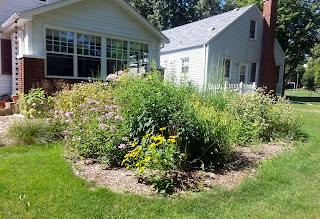August 20th, 2018 by Hope Charters
A smartphone app named “Rain Garden,” designed to help people plan and build rain gardens across America, is now customized with a specialized list of plants suited for Indiana. Through video tutorials, diagrams and tools, the app makes it easy to learn the basics of designing, installing and maintaining a rain garden.
Many people and communities use sustainable landscape design and management practices, such as rain gardens, to prevent polluted stormwater runoff from flowing into nearby rivers and streams and harming the water supply. To stop runoff from reaching water bodies, stormwater can be directed toward rain gardens to be absorbed by plants and soils.
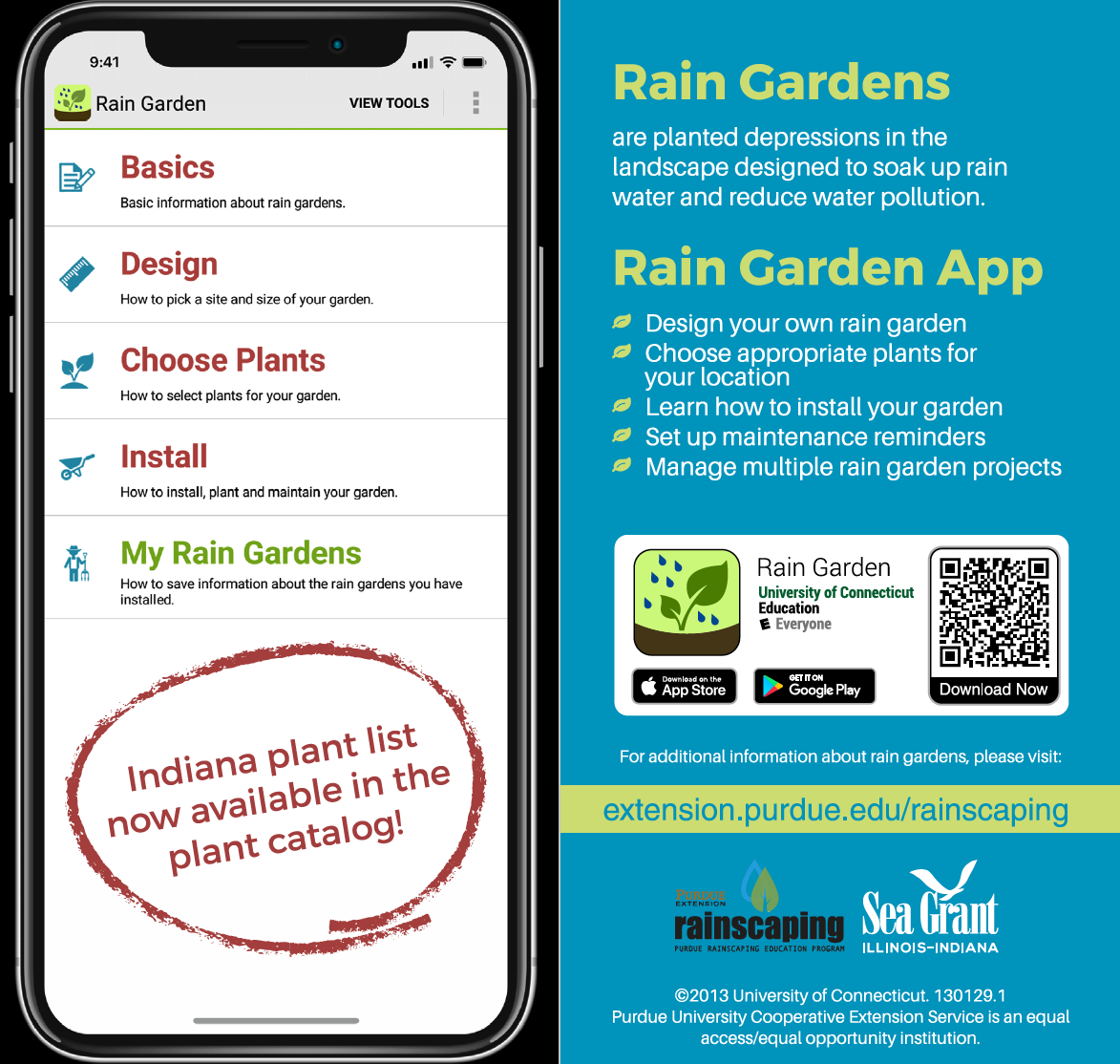
Hoosiers can download “Rain Garden” for free through the Apple or Google app store. Created at the University of Connecticut, the app includes tools for determining soil type, measuring the area needed for the garden, and managing multiple rain garden projects.
The Indiana plant list was made possible by Kara Salazar of Illinois-Indiana Sea Grant and the Purdue Rainscaping Education Program, Rosie Lerner of Purdue Horticulture and Landscape Architecture, John Orick of the Purdue Master Gardener program, Kris Medic of the Purdue Extension Community Development program, Jane Frankenberger of Purdue Agricultural and Biological Engineering, and Laura Esman of Purdue Forestry and Natural Resources.
October 17th, 2017 by iisg_superadmin
Illinois-Indiana Sea Grant (IISG) plans to award $675,000 to four new research projects that will help inform decision makers as they address some of the region’s pressing environmental issues, including managing stormwater, restoring stream habitats and protecting beachfronts. The research will take place in 2018-2019.
Two projects will focus on green infrastructure as part of stormwater management, but using different approaches. At the University of Illinois, landscape architect Mary Pat McGuire will lead a diverse team that includes David Grimley with the Illinois State Geological Survey (ISGS) to create a soils database for the Calumet region southeast of Chicago to assess soil health and appropriateness for effective green infrastructure. The researchers will evaluate green infrastructure planning in the region and work with municipalities in pilot projects to help integrate their findings into site selection and design strategy decisions.
Bernie Engel and colleagues in the Purdue University Department of Agricultural and Biological Engineering will enhance their simulation software to include the long-term effects of green infrastructure on reducing and preventing flooding. Their model is part of the Tipping Point Planner online toolbox, which helps local decision makers plan for future development in their communities. This new project will be closely tied to a south side Chicago neighborhood—Washington Park. There, using their updated model, the research team hopes to demonstrate the impact of optimally-places green infrastructure on flooding. Akilah Martin, in DePaul University’s School for New Learning, will help share these results with students and local residents.

Washington Park, Chicago, Illinois
At the University of Illinois, hydrogeologist Piotr Cienciala and ecological physiologist Cory Suski will lead a multi-disciplinary project to study the effect of turbulence on fish swimming behavior. By studying how the physiology of various fish species is affected by water movement, the researchers can help inform the placement of fish passage structures as part of stream restoration projects. The findings will likely be transferable to stream projects beyond the Great Lakes region and may help inform simulations to explore restoration outcomes under various projected climate or land use change scenarios that alter water movement and fish habitat.
U of I researchers will also use historical documents of the geology of the Illinois shoreline to help beach managers predict and address future conditions. Through old photos and reports, ISGS’s Ethan Theuerkauf will lead an effort to tell the story of land changes and environmental conditions over the last century at Illinois Beach State Park. Experts from the Prairie Research Institute, Midwest Regional Climate Center, and Great Lakes Integrated Sciences and Assessment Center are also taking part in this research. Working closely with beach managers, the researchers will develop future coastal change scenarios to help inform the decision making process.
“Illinois-Indiana Sea Grant is excited to support these new research efforts,” said Tomas Hook, IISG associate director for research. “They are targeting issues that have been identified as priorities for the Lake Michigan region of Illinois and Indiana and they have great potential to yield solution-based results for our region. Collectively, these projects should also contribute to informing infrastructure and environmental management in coastal regions throughout the United States.”
Illinois-Indiana Sea Grant is a part of University of Illinois Extension and Purdue University Extension.
April 5th, 2016 by IISG
University of Illinois PhD students Pongsakorn “Tum” Suppakittpaisarn, pictured above on the right, and Fatemeh Saeidi-Rizi, pictured above on the left, study rain gardens—but not in the way you’d expect. Instead of measuring infiltration rates and pollution reduction capacity, Tum and Fatemeh want to know what happens in our brains and bodies when we see this green infrastructure practice.
A growing number of studies draw connections between access to green spaces and our physical and mental health. But, Tum said, most of that work has revolved around larger, more ubiquitous landscapes like public parks and tree-lined streets.
“We know green spaces generally are good for mental health,” he said. “But the ‘how’ and ‘why’ is still unclear, especially with rarer landscape types like rain gardens.”
So Tum and Fatemeh, along with collaborators at the University of Illinois’ Sustainability and Human Health Lab and the Health People-Health Landscape Lab at National Taiwan University, are working together to measure physical responses and changes in brain activity triggered by images of rain gardens.
The team has compiled 216 rain garden photos taken across the U.S. into nine different videos. In Illinois, Tum will use biofeedback sensors to measure what happens to participant heart rates, body temperatures, and more when they see these videos.

At the same time, Dr. Chun-Yen Chang’s team in Taiwan will use functional magnetic resonance imaging—better known as fMRI—to monitor and map changes in brain blood flow when participants are shown rain garden photos after being put through a series of tests designed to cause mental fatigue.
The researchers only began testing participants this spring, but they have a few predictions about the final results.
“It’s possible that seeing rain gardens in an urban space will help people recover from mental fatigue faster,” said Tum. “On the other hand, rain gardens with a lot of messy plants may make people feel uncomfortable, which may lead to them feeling more stress or mentally fatigue.”
October 21st, 2015 by iisg_superadmin
It is not uncommon for more than one home on a block to have excess water due to stormwater runoff. The good thing about a rain garden is that they can adapt to suit the need of the homeowner. They can be placed wherever on the property they are needed.
Originally Dan and Libby Reimann’s Mount Prospect, Ill. home did not have any problems with standing water. It was not until the couple had an addition built onto their house did they encounter problems. During the construction, their sump pump began to run continuously, flooding their front yard and a portion of the neighbor’s driveway. When the couple contacted local authorities, they were given two suggestions, the Reimanns could tap into the sewer system or they could build a rain garden.
The couple didn’t want to tap into the sewer system if they could avoid it and the village encouraged the idea of a rain garden. With some deliberation as well as online searching and learning more about rain gardens, Dan and Libby decided they would try to build one.
In Dan’s research he came across Kevin Herbert, a landscaper in the northwest suburbs of Chicago. They contacted Herbert to design and construct their garden. Not knowing exactly what they wanted or what to put in the garden, they gave Herbert free reign. From the shape of the garden to the flowers in the garden, Herbert did it all.
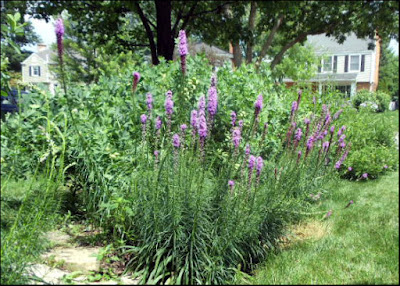 Not only did Herbert take charge of the whole design process but he also helped in the garden’s maintenance. The couple hired him to take care of the garden following its first year of installment. In that year he taught them what to weed, when to cut down plants and provided the couple with pictures of what each plant should look like when fully grown as a way to tell them apart. He left them the initial sketch of the design of the garden with what flowers go where.
Not only did Herbert take charge of the whole design process but he also helped in the garden’s maintenance. The couple hired him to take care of the garden following its first year of installment. In that year he taught them what to weed, when to cut down plants and provided the couple with pictures of what each plant should look like when fully grown as a way to tell them apart. He left them the initial sketch of the design of the garden with what flowers go where.
The Reimann garden is full of blooming flowers. They were particularly happy with the selection because they were picked to ensure that flowers are always in bloom, spring through fall. In the spring, the garden is adorned by blue and pink from the blue flags, blazing star and prairie smoke. When summer begins, the Reimanns can start to see white, purple and yellow from the meadowsweet, Monarda and black-eyed Susans. Black-eyed Susans are joined by white turtlehead and New England asters bloom in the late summer to early fall. The garden keeps these colors until the frost.
Dan’s advice to homeowners who know little to nothing about rain gardens, is to not let fear stop them. “They should just go for it,” Dan said. “And don’t be afraid to ask for help.”
When their neighbor Amy Hempleman saw how well the garden was working she took his advice, even taking their suggestion of having Herbert help create their garden in the spring of 2014.
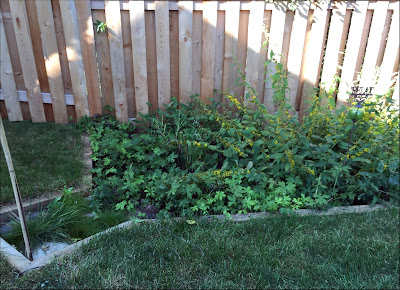 The Hempleman garden was different in one major way—the location. While water was spilling into the front of the Reimann’s yard, Hempleman had to solve a problem in the backyard. The back corner just behind the garage began to flood from excess water coming from the gutters. Hebert used this as well as the natural slope of the yard to his advantage when he designed this garden. The water is routed along the sidewalk downspout and into the garden.
The Hempleman garden was different in one major way—the location. While water was spilling into the front of the Reimann’s yard, Hempleman had to solve a problem in the backyard. The back corner just behind the garage began to flood from excess water coming from the gutters. Hebert used this as well as the natural slope of the yard to his advantage when he designed this garden. The water is routed along the sidewalk downspout and into the garden.
Hempleman is very happy with the garden, describing it as attractive and bright in the summer. When in full bloom, the garden has bluejackets, broad leaf goldenrod, nodding onion as well as ivory sedge and plantain leaved sedge. The balance between flowers and grass-like plants creates a full garden that does its job as well as adding to Hempleman’s yard.
Not only was Hempleman happy with the garden’s appearance, but she also feels good about the way it took care of the water problem. This experience has given Hempleman a new interest in plants, to be more specific, with native plants. As she has seen the beauty and functionality of them firsthand, she has started to notice and look for them. She expressed a wish for clearer labels of plants, to make it easier for gardeners that want to find native plants. This would also educate people who may not know the native plants of their area and could pique their interest.
Hempleman looks forward to watching her garden grow in the upcoming years.
-Victoria Figueroa
September 21st, 2015 by iisg_superadmin
Honors and AP high school students from Howard County, Ind. got their feet really wet Thursday at the 2015 Wildcat Experience at
Wildcat Creek near Kokomo.
The program was started by Howard County Stormwater Technician Sarah Brichford with important goals for these high achievers.
Wildcat Creek is 84 miles long and a major tributary of the Wabash River. In 2003, a study showed that most of its pollutants are from urban and rural run-off and wastewater discharge. Since then, state and local governments have taken steps to stem the flow of contaminants.
Plus, they decided to bring youth into the picture.

“We wanted to get high school students who are taking biology and environmental sciences out into the community so they could see some local natural resources, and more importantly, some of the services and infrastructure that depend on the natural environment like wastewater, drinking water, and stormwater treatment,” Brichford said.
“That’s why we created this, so they could experience it live and in person.”
Six years and hundreds of students later, Wildcat Experience is thriving and educating students with the help of volunteers and IISG specialists.
Jay Beugly, an IISG aquatic ecologist, shared his expertise on the region’s fish and aquatic insects. He was also hoping to change a few minds about the pollution stigma the Wildcat carries to this day.
“Typically students that come to this don’t get in the water initially because they think it’s so polluted,” Beugly said. “But I hope they go home and tell family that it has a lot of good fish and insects that don’t occur in terrible streams. I hope that they’ll decide that Wildcat Creek is a lot better than they initially thought.”
So after fish, water, macroinvertebrate, and soil testing some of the students felt differently about the creek right in their backyard.
“There’s a lot more diversity than you would think there would be in Indiana,” senior Sarah Schwarzkopf said.
“I always thought the Wildcat was really dirty, but after all the tests we did it’s really not that bad.”
August 3rd, 2015 by iisg_superadmin
The first thing I noticed when walking toward Bob and Nancy Larson’s house is the beautifully manicured centerpiece in his perfectly trimmed lawn. It’s hard to miss. The tall plants grab your attention long enough to realize that not everything is green. A closer look and little spots of color start to stand out. There is purple from the Joe Pye Weeds, yellow from the black-eyed Susan and light blue from the wild prairie petunias. The garden shines.
But this garden is more than a centerpiece. It is a tool.
When the Larson’s moved into their Champaign, Ill. home in 2009, they were excited to settle into their new neighborhood. However, just three days after they moved in, their basement flooded from the sanitary sewer backing up. It was then when Larson was made aware of the stormwater issues in his neighborhood. It also did not help that 2009 was the fifth wettest year on record since 1889. Seeing how having a flooded basement could become a continuous problem in the future, he decided to research ways he could prevent the buildup of water. That was when he discovered rain gardens. In conducting his research he became more and more interested in installing one of his own.
With the help of The Blue Thumb Guide, he started to design his own garden. He drew inspiration from designs he found in other books, online, and from visiting other gardens. When it was time to pick plants to place in his garden, he was drawn to native plants and made a conscious effort to seek those out. He visited nurseries to find the best plants for his garden, as well as using the book Native Plants in the Home Landscape for the Upper Midwest to organize his choices.
When it came time to start digging in his yard, Larson was optimistic, that is until he discovered there were layers of rocks under his soil. Even though this was an inconvenience for him, he patiently relocated the rocks and continued to carefully dig.
He placed the garden in the center of his front yard, to draw water away from his home. Blooming flowers on the outer part of the garden act almost as a lining. When in full bloom, there are many colors jumping out–they are very pronounced against the white of his house and really do act as a centerpiece in his lawn. In the center of the garden are plants with thicker stems as well as grass-like plants, such as purple coneflowers, sideoats grama, little bluestem, and big bluestem. This creates a very full yet manicured garden, yet the chaos that could happen with such a large array plants is contained.
Larson advises people to not over plant their garden as it can become more difficult to maintain a clean look, if that is what they want. He also stresses the importance of knowing the soil type. He has very fertile soil that drains well, so he chose not to add sand.
“I think it would have helped if I would have added sand to cut down on the fertility so stuff wouldn’t grow so big,” he said. “It’s kind of hard to do that afterwards.”
When installing a rain garden it is important to know what kind of garden your want, so even if you choose to do it on your own like Larson, it is still very manageable and attainable.
-Victoria Figueroa
June 10th, 2015 by iisg_superadmin
Victoria Figueroa is a summer intern with IISG. She is on the University of Illinois campus, working with Eliana Brown, stormwater specialist. She will be engaged in raising awareness about the benefits and beauty of rain gardens.
A Chicagoan born and raised, I was not used to being surrounded by so much green. There are plenty of parks in the city, but you never feel like you are surrounded by nature. But when I moved to Urbana for school, I realized just how much of a city kid I was and how much I could enjoy being surrounded by so much green, in particular trees. One night, walking around campus with a couple friends, we thought we would try our luck at climbing trees. This may not have been the best idea as it was dark and the two big (oak, I later learned) trees were surrounded by rocks and overgrown shrubs. But the light coming from the detention pond not too far away was enough to give us the confidence to try.
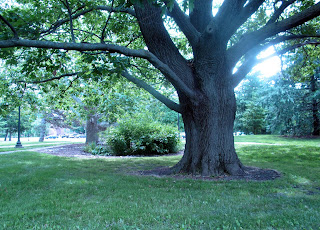
Now I didn’t succeed, but what was once just a meaningless patch of land on my campus, became a memory I now have a great fondness for. Just imagine my surprise when I learn that those rocks and shrubs I was playing in were not just there for decoration. Those stones and plants were not just there as placeholders. That night my friends and I had played in a rain garden. Our amusement might not have been the use the gardeners and students who built the garden had in mind, but it was very natural.
But what is a rain garden? A rain garden is built in a bowl shape, which gives rainwater runoff from surfaces that do not absorb water, like roofs, sidewalks, and roads, the opportunity to be absorbed. This helps to control flash floods, remove pollutants, improve water quality, and recharge groundwater. Not only do these gardens provide wildlife habitats, but are also an attractive alternative to detention ponds and can be adapted to fit into the existing urban landscapes. This is why it was so easy to walk through a rain garden on my college campus. It did not feel out of place. It was not intrusive and blended well in between the dorm building and its surroundings.
Rain gardens are a relatively new approach to treating stormwater runoff. Stormwater runoff is any water originating from rainfall or melted ice or snow. Stormwater runoff not only transports pollutants, but is also a creator of pollution itself. A study conducted by the Environmental Protection Agency from 1979-1983 found that stormwater runoff contributed to poor water quality in receiving streams. This can be particularly harmful in urban areas because of the great amount of hard surfaces like roads, walkways, and parking lots that do not allow water to be absorbed. This then causes a larger percentage of stormwater runoff than in more rural areas. Therefore it is important for urban areas to be able to manage the excess water that comes along with living in our concrete jungles. Rain gardens were created to mimic natural water retention areas, which existed before the development of urban environments and they began to be developed for residential use in 1990.
There are many ways of going about treating water in urban areas, and rain gardens are a good way to start. They are unassuming and they can be implemented in your own yard. Not only are rain gardens helpful but they can very beautiful as well. Like any garden, its appearance can vary. It really depends on what the gardener makes of it. Rain gardens could have more plants that resemble grass and be very subtle or many blossoming plants and add more color to their yard.
Maybe one day I’ll have one in my own back yard. But first I invite you to follow me in my future blog posts as I search for the perfect fit for my future garden, whether I keep Chicago as my home or move away and settle down elsewhere.
April 7th, 2015 by iisg_superadmin
Residents across Illinois and Indiana are taking advantage of the warmer weather to plan garden and yard projects. Adrienne Gulley shares some with easy tips for keeping your lawn green and the water clean.
 Nothing is more appealing than fresh flowers and green grass. But the chemicals we put on our lawns each year can end up in our lakes and rivers, where they lower water quality and harm aquatic ecosystems. Fortunately, you don’t have to give up your beautiful landscape to protect our waterways. This summer, take the Lawn to Lake pledge and adopt these natural lawn care practices:
Nothing is more appealing than fresh flowers and green grass. But the chemicals we put on our lawns each year can end up in our lakes and rivers, where they lower water quality and harm aquatic ecosystems. Fortunately, you don’t have to give up your beautiful landscape to protect our waterways. This summer, take the Lawn to Lake pledge and adopt these natural lawn care practices:
- Mow at a 3” or higher. Longer grass shades out weeds and retains moisture better.
- Leave grass clippings on the lawn. They’re a natural fertilizer.
- Aerate soil to reduce compaction.
- Water deeply, slowly and infrequently to build healthy root systems.
- Test your soil to determine your fertilizer needs.
- Fertilize with a thin layer of compost in the spring and fall.
If you aren’t practicing these tips already, it may be a good idea to simply focus on one tip at a time. Understanding the impact of nutrients from our lawns is the key to keeping our waterways healthy.
I will be sharing these and similar tips with members of the Illinois Lake Management Association during their Point of Discussion educational series tonight in Springfield. Visit lawntolakemidwest.org for more information.
March 3rd, 2015 by iisg_superadmin
Stormwater management in Indiana is getting a shot in the arm next month with the launch of the Rainscaping Education Program.
 A collaboration between Purdue Extension, IISG, and others, the program provides how-to information and resources on landscape design and management practices that help prevent polluted stormwater from reaching local waterways. Practices are appropriate for both residential gardens and small-scale public spaces, including schools and community centers.
A collaboration between Purdue Extension, IISG, and others, the program provides how-to information and resources on landscape design and management practices that help prevent polluted stormwater from reaching local waterways. Practices are appropriate for both residential gardens and small-scale public spaces, including schools and community centers.
It all starts April 14 with the first in a series of workshops focused on rain gardens. Over the course of five three-hour sessions, participants will visit and discuss existing rain gardens in the community and learn how to design, construct, and maintain one with a focus on community education. They will also get a chance to test their knowledge by collaborating on a demonstration rain garden with community partners.
The Rainscaping Education Program is open to Purdue Master Gardeners, personnel at conservation organizations, stormwater professionals, and landscape professionals and consultants. For more information and to learn how to register, visit the program website.
***Photo: The plants and soil in rain gardens help absorb stormwater and filter out pollutants. Courtesy of the Champaign-Urbana Residents for Raingardens and BioSwales.





